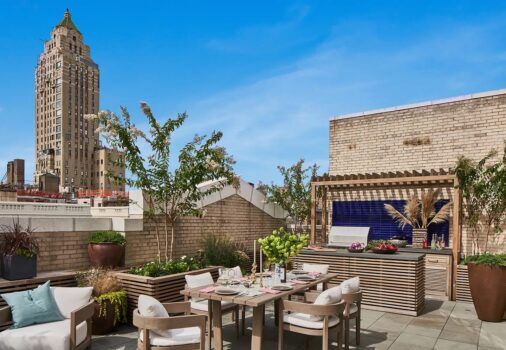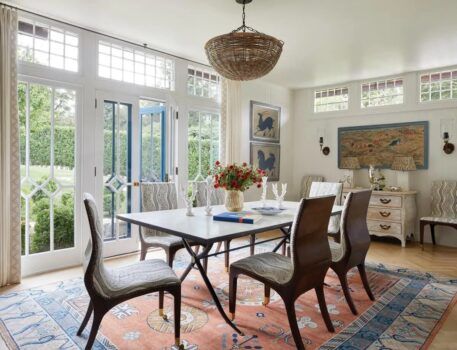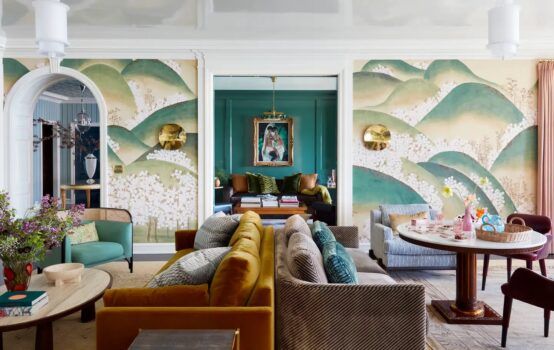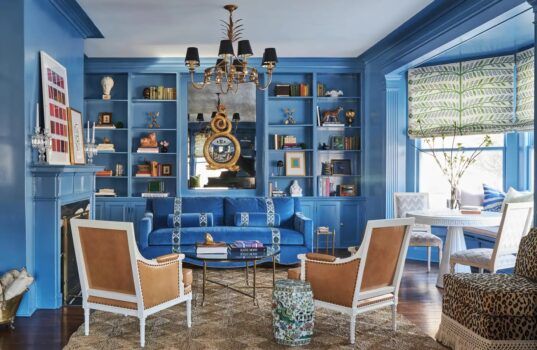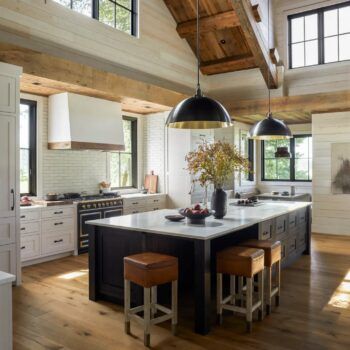In the bright white living room of a Manhattan apartment with interiors by David Kleinberg Design Associates, a pared-down color scheme allows a meditative painting by Y.Z. Kami to speak volumes.
“The palette was deliberately arranged to be quiet so that the art could generously grace the space,” says Kleinberg, who collaborated with architect Stephen Wang and the homeowners in honoring the bones of the classic prewar apartment while upgrading it for modern life.
The clients, a Connecticut-based couple of Persian ancestry, are avid collectors of contemporary Iranian and mid-20th-century art, which plays a key role in the home’s identity.
The Kami piece is complemented by a bronze Ingrid Donat coffee table inspired by tribal tattoos, as well as a custom crescent-shaped sofa, Art Deco–style armchairs and an Angelo Brotto for Esparia Sassone glass table lamp from Gaspare Asano that brings color shine to the neutral space.
A 1971 Alexander Calder mobile suspended nearby balances motion and stillness, its dark color providing a yin-yang counterpoint to the room’s overall lightness.
For the bedroom of a beachfront Miami condo, Sean Webb and Brent Leonard, coprincipals of Formarch, drew inspiration from local mid-century-modern traditions and the ocean beyond the tall sliding-glass doors.
“We set out to design a peaceful, contemplative space that feels connected to the Miami coastline — something that nods to the natural calm of the landscape while also inviting a sense of introspection,” Leonard says.
Untitled 3, an oil painting by Gayatri Gamuz, hangs above the platform bed, reflecting the sea, sky and horizon outside — although its colors invert reality. “It set the mood with its soft abstraction and tonal restraint,” the designer notes, “in a way that feels effortless and intentional.”
The space features custom white-oak side tables and a Formarch x Sacco rug.
International vintage pieces include a 1960s Bertomeu & Cia Brazilian-modern armchair, a 1970s Bergboms Swedish brass floor lamp with a rattan shade and a 1960s Bonacina Italian rattan side table, all sourced from 1stDibs. A pair of cobalt-blue Scandinavian ceramic lamps provides deep contrast within the light palette.
When updating a Victorian house in San Francisco, Geremia Design crafted a sitting room that does double duty as a gallery space. Positioned just off the main entry, it is designed to flexibly accommodate the family’s growing art collection.
“We placed the artworks with that in mind, starting with large-scale pieces to set the tone and scale while leaving enough flexibility for the collection to evolve and rotate over time,” says the firm’s principal, Lauren Geremia.
A commanding black-and-white abstraction by Adam Fuss pulls the eye upward, emphasizing the high ceiling and historical detailing.
“The art helped us draw attention to the verticality of the space,” Geremia explains. “It adds drama and also an emotional, tactile layer to the experience of walking into the home.”
To facilitate viewing the artworks, seating and tables were kept centered and open, enabling easy conversation and a smooth flow between the adjoining bar, dining room and main living area.
A Living Divani sofa, John Lubberts and Lambert Mulder walnut chair and blue Stahl + Band side table rest on or near a wine-hued rug.
“The goal,” Geremia says, “was to create a warm and cohesive foundation with a clear point of view while still leaving room for the future.”
In his Greenwich Village abode, designer Shawn Henderson set out to create what he describes as “the feeling of an elevated loft.” He painted the exposed-brick walls white to amplify the light and emphasize the art. “The use of colorful and large-scale art makes the space feel gallery-like,” Henderson says.
The standout work is Ich Halte Dich Fest Halten II (“I Hold You Fast”), 2018, by Ethiopian artist Tesfaye Urgessa displayed prominently against the blanched brick. “I chose this piece because I loved the story it told, and the composition just spoke to me,” the designer says.
He layered in a mix of custom and vintage furnishings, including a Shawn Henderson x Rupp Studio sofa and table lamps, reproductions of 1930s Danish-style club chairs, a 1960s Erling Viksjø coffee table and a pair of T.H. Robsjohn-Gibbings for Widdicomb Parsons end tables.
A Marc Phillips area rug and drapes composed of Schumacher fabric with Wesley ticking further cozify the industrial space. When it comes to choosing art, Henderson advises, “buy what you love, and don’t be afraid to mix it up.”
For their country house in New York’s Hudson Valley, Britt and Damian Zunino, of Studio DB, took cues from Charles and Ray Eames’s famous Case Study House #8, incorporating modular volumes and glass expanses that provide a seamless connection to the outdoors.
The living room especially reflects the Eames influence, in its use of natural materials, vintage textiles and potted plants, all overseen by a monumental collage by the artist collaborative Ghost of a Dream.
“We wanted the space to feel layered, warm and grounded — an effortless mix of modern design and soulful materials,” says Britt. “The large-scale piece by Ghost of a Dream brings that balance to life. Its geometric composition adds structure, while the tactile, almost quilted collage texture softens the space and echoes the natural surroundings just beyond the glass.”
The artwork, composed of postcards arranged in a repeating diamond pattern, holds personal significance for the couple. Its creators are affiliated with the Wassaic Project, a nonprofit artist residency cofounded by Damian’s sister.
“It has a strong visual rhythm but also a handmade sensitivity that resonates with the natural palette and vintage textiles throughout the room,” Britt says. “What we love most is how it feels at once contemporary and timeless.”
The seating area contains a Lucidi Pevere slat-back Yak sofa, a pair of Milo Baughman lounge chairs from 1stDibs reupholstered in a vintage indigo Guatemalan textile, a Costela sofa by Carlo Hauner and Martin Eisler and a purple daybed from ABC Carpet & Home.
Josh Greene’s Loma coffee table, from Dowel Furniture; a mid-century Eero Saarinen for Knoll side table; and a BDDW credenza provide surfaces on which to set a drink or a book. A cream Nordic Knots rug ties it all together.
“Let the art be the anchor and lean into it,” Britt says. “It defines the focal point and informs the palette without competing with the furniture.”
Jessica Schuster envisioned the foyer of a Mediterranean-style home in Palm Beach as a study in contrasts. “I wanted to create a sense of sculptural calm and refined drama in this entry space,” she says.
The designer sought to enhance the organic sophistication of the swirling plaster staircase and arched passageways by bringing in just a few bold pieces. The vivid painting by Sterling Ruby introduces a sharp counterpoint to the space’s natural materials and hues.
“This piece struck me with its dynamic movement and richness of texture,” Schuster says. “The slashing lines and saturated colors — red, gold, black and teal — contrast beautifully against the soft plaster walls. It pulls your gaze instantly and anchors the space emotionally.”
Furnishings like a suede-upholstered sofa by Khaled El Mays, from Nilufar Gallery; a classic Jean-Charles Moreux center table; and a contemporary Leo Sentou side table were chosen to introduce varied silhouettes without visually cluttering the vibe.
“Large-scale works can set the tone for an entire space,” Schuster says. “When art feels like it belongs in the architecture rather than just being placed there, it creates magic.”
In the expansive kitchen of a contemporary Northern California house designed by architect Tom Kundig, interior designer Nicole Hollis embraced what she calls “the serenity of minimalist design.”
Working within the home’s epic scale, she focused on elemental materials — bronze, marble, oak and plaster — to create a space that feels both muscular and touchable.
A cinematic canvas by Oscar Murillo, from the homeowners’ collection, adds expressive energy to the otherwise hushed decor. “I personally like the boldness and colors in the painting that activate the room,” Hollis says. “Using large-scale works in a space can signal a sense of confidence and a certain fearlessness.”
The kitchen features custom bronze shelving by Hollis and Kundig, along with bespoke bronze hardware and a marble island countertop. White-oak casework, white marble surfaces, burnished-limestone flooring and a hemlock-wood ceiling create a sturdy framework.
Molly Kidd — formerly of Light and Dwell and now principal of her own studio — embraces a philosophy of “quality over quantity, and a balance of vintage and new” in her family’s new house in the Oregon countryside.
In the hallway off the living room, she placed a vintage rustic bench below a striking canvas by Lori Primrose, conceived to melt into its surroundings.
“When selecting art for my hallway, I couldn’t find the perfect piece on the market, so I commissioned one by Lori Primrose,” Kidd says. “I wanted an abstract painting that was textural and full of depth. I sent her four of the paint colors from throughout my home to incorporate in it. It feels deeply personal and meaningful.”
Ceramics from a local antique store and a glass vase from Hein Studio round out the vignette, demonstrating Kidd’s instinct for combining handmade, collected objects in intentional ways.
A light installation by Robert Irwin fills one wall in the main gathering space of an ultramodern Bel-Air manse designed by Bryan O’Sullivan, who was brought in to instill a sense of intimacy in the expansive architecture and create distinct zones for lounging and socializing.
O’Sullivan selected a mix of 1970s furnishings — including Jacques Charpentier’s steel-and-leather lounge chairs, a chrome-and-glass table by François Monnet and a de Sede Snake sofa — arranged to maximize the bucolic views through the floor-to-ceiling windows.
Items from the 1960s, like a Dieter Rams hi-fi, George Nakashima lamp and Osvaldo Borsani table, mingle with more-recent creations, such as Raphael Navot’s Moon sofa, Draga & Aurel’s blue-resin-and-concrete bench and Based Upon’s Fragmented Crack coffee table.
“Our clients themselves were a huge source of inspiration for this project,” O’Sullivan says. “They’re a bold and adventurous couple with impeccable taste. So, it was really important that this was reflected in the design — and their personalities came through.”
Jose Dávila’s Untitled (Femme d’Alger XI) jazzes up the sumptuously layered study of a late-19th-century Connecticut house by architect Ehrick Rossiter, with interiors colorfully refreshed by Clive Lonstein.
“The intention was to craft a space that felt immersive and dynamic — where art is not just an accent but an integral part of the design narrative,” Lonstein says.
The 2016 archival pigment print is a Russian matryoshka doll of references: It is a distillation of Roy Lichtenstein’s 1963 Femme d’Alger, which is a riff on Pablo Picasso’s 1954–55 series “Les Femmes d’Alger,” itself inspired by Eugène Delacroix’s 1834 painting The Women of Algiers in their Apartment (Les Femmes d’Alger).
“This piece was selected for its striking composition and ability to hold its own within a richly colored space,” Lonstein explains. “The contrast of structured lines against the softer organic elements in the room creates a compelling visual tension.”
The homeowners are collectors of furniture as well as art. Top-notch designs here include a ca. 1960 Carlo Hauner for Forma Brazil lounge chair, a 1972 Greta Magnusson-Grossman coffee table and a Luigi Scremin cabinet.
“Let the artwork be a defining focal point,” Lonstein advises. “When using large-scale pieces, ensure they have room to breathe. Balance them with complementary colors and textures to integrate them seamlessly into the space rather than overpowering it.”











